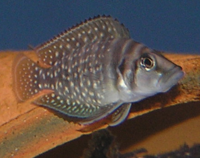| Altolamprologus | ||||||||||||
|---|---|---|---|---|---|---|---|---|---|---|---|---|

Altolamprologus calvus
|
||||||||||||
| Scientific classification | ||||||||||||
|
||||||||||||
|
Altolamprologus is a small genus of cichlids with only two species. Both species are laterally compressed cichlids which prey primarily on invertebrates, though will also consume fry of other fish. The species both inhabit areas of the lake with large amounts of rock, most frequently in water two to ten metres in depth. Some authors (eg: Konings, 1998) include Neolamprologus fasciatus in the genus Altolamprologus.
Contents |
Altolamprologus calvus
A. calvus (Poll, 1978) is a cichlid endemic to Lake Tanganyika in east Africa. The species has greatly laterally compressed body and a high dorsal fin. The fish may grow to 13 cm (5 inches), though are normally smaller. While not highly sexually dimorphic males tend to grow more quickly and to a larger size than most females.
Altolamprologus compressiceps
Altolamprologus compressiceps (Boulenger, 1898) is physically similar to A. calvus, though it is deeper bodied and has a shorter snout than A. calvus.

In the aquarium
Altolamprologus species is not difficult to keep, if given the standard Lake Tanganyikan water parameters. The species can be a challenge to breed for the novice. It is a very slow-growing species that can take two years to grow from 2.5 cm (1 inch) to sexual maturity. The fish are both cave spawners and will spawn under terracotta pot saucers or in shells.
References
- Altolamprologus (TSN 648018). Integrated Taxonomic Information System. Accessed on 6 June 2006.
- Konings A (1998) Tanganyikan cichlids in their natural habitat. Cichlid Press.




 216.73.216.190
216.73.216.190 User Stats:
User Stats:
 Today: 0
Today: 0 Yesterday: 0
Yesterday: 0 This Month: 0
This Month: 0 This Year: 0
This Year: 0 Total Users: 117
Total Users: 117 New Members:
New Members:
 216.73.xxx.xxx
216.73.xxx.xxx
 Server Time:
Server Time: